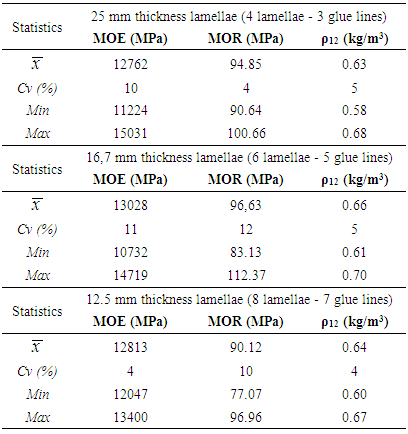-
Paper Information
- Paper Submission
-
Journal Information
- About This Journal
- Editorial Board
- Current Issue
- Archive
- Author Guidelines
- Contact Us
International Journal of Materials Engineering
p-ISSN: 2166-5389 e-ISSN: 2166-5400
2016; 6(2): 51-55
doi:10.5923/j.ijme.20160602.05

Influence of Lamellar Thickness on Strength and Stiffness of Glued Laminated Timber Beams of Pinus oocarpa
Felipe Hideyoshi Icimoto1, Carlito Calil Neto2, Fabiane S. Ferro1, Laurenn Borges de Macedo1, André Luis Christoforo3, Francisco Antonio Rocco Lahr4, Carlito Calil Júnior4
1Department of Materials (SMM), São Paulo University (EESC/USP), São Carlos, Brazil
2Wood and Timber Structures Laboratory (LaMEM), São Carlos Engineering School, São Paulo University - USP, São Carlos, Brazil
3Centre for Innovation and Technology in Composites – CITeC, Department of Civil Engineering (DECiv), Federal University of São Carlos, São Carlos, Brazil
4Department of Structural Engineering (SET), São Paulo University (EESC/USP), São Carlos, Brazil
Correspondence to: André Luis Christoforo, Centre for Innovation and Technology in Composites – CITeC, Department of Civil Engineering (DECiv), Federal University of São Carlos, São Carlos, Brazil.
| Email: |  |
Copyright © 2016 Scientific & Academic Publishing. All Rights Reserved.
This work is licensed under the Creative Commons Attribution International License (CC BY).
http://creativecommons.org/licenses/by/4.0/

Glued laminated timber is a structural engineered product that requires precision and strict quality control in its manufacture. For ensure that produced elements properties are in compliance with regulatory requirements, final product must be tested under laboratory conditions. Determining factors in final glulam pieces cost are the type and the quantity of adhesive used in structural elements manufacture. This study aimed to investigate, aided by three point static bending tests and variance analysis (ANOVA), influence of glue lines (3, 5, 7) and lamellae (4, 6, 8) on strength (MOR) and stiffness (MOE) properties of glulam beams manufactured with Pinusoocarpa (CCA treated) and bonded with Phenol Resorcinol resin (Cascophen RS-216-M). These beams presented nominal dimensions 90mm wide; 100mm height; and 1350mm length. For 100 mm fixed height, three beams configurations were tested (a) with four lamellae of 25 mm (3 glue lines); with 6 lamellae of 16,7 mm (5 glue lines) and 8 lamellae of 12.5 mm each (7glue lines), being fabricated 6 beams for experimental condition. In addition to investigating influence of glue lines and lamellae number, possibility of estimating MOE and MOR based on apparent density was also evaluated. ANOVA results showed no significance about glue lines number (or lamellae thickness) in strength and stiffness values, implying, for economic reasons, be configuration with four 25mm lamellae the best among tested beams. From regressions, apparent density was only significant in MOE estimating (R2 = 46.90%), indicating not be possible to estimate the stiffness and strength values of the glued laminated timber evaluated by the apparent density.
Keywords: Glued laminated timber, Lamellae thickness, Lamellae number, Mechanical performance, Pinus oocarpa
Cite this paper: Felipe Hideyoshi Icimoto, Carlito Calil Neto, Fabiane S. Ferro, Laurenn Borges de Macedo, André Luis Christoforo, Francisco Antonio Rocco Lahr, Carlito Calil Júnior, Influence of Lamellar Thickness on Strength and Stiffness of Glued Laminated Timber Beams of Pinus oocarpa, International Journal of Materials Engineering , Vol. 6 No. 2, 2016, pp. 51-55. doi: 10.5923/j.ijme.20160602.05.
1. Introduction
- Glued laminated timber (Glulam) is a structural product used for many years in countries with extensive experience in build timber structures, such as USA, Canada, Germany and Switzerland [1].As an engineered product, its production process requires an industry with quality control on manufacturing steps by trained manpower and raw material with compatible performance to requirements of products [2-6].To ensure that the Glulam element properties are in compliance with normative requirements and material strength is specified according to current codes, the final product must be tested under laboratory conditions [7].Nowadays, Glulam production in Brazil is still not so wide, being necessary greater disclosure of this technology, by uniting efforts of researchers, engineers, architects and industries. This is, therefore, a possible way to Glulam achieve visibility, competitiveness and economic viability in relation to other structural materials [1, 8-10].In order to provide competitiveness to Glulam in opposite to other building materials, such as reinforced concrete and steel, beyond of disclosure aiming to increase demand, it is also necessary to develop researches aiming lowering final product cost, that can occur with improvement of manufacturing processes as well as with raw materials economy [4, 6].Raw materials used to produce Glulam are wood and adhesive. Wood is the main element and adhesive is responsible to join together timber pieces for adequate shaping the final products. Cost of adhesive, in several cases, can be higher than wood. Therefore, usually it is preferable to use more wood and less adhesive. Consequently, more glue lines in structural elements will signify the higher products cost [8].Considering the possibility of economy and more rational use of glued laminated timber, this study aimed to investigate influence of glue lines number (or number of lamellae) on strength (MOR) and stiffness (MOE), in static bending, of glulam beams produced with CCA (Chromated Copper Arsenate) treated Pinus oocarpa.Besides, this research also aimed to evaluate the possibility of estimating these properties based on apparent density, once it's a wood characteristic of easy determination.
2. Material and Methods
- Wood species used for specimen fabrication was Pinus oocarpa, air-dried (12% moisture content) and CCA treated.Modulus of elasticity (MOE) and modulus of rupture (MOR) of Glulam beams (nominal dimensions 90 mm wide; 100mm height; and 1350mm length) were obtained using three point static bending tests (Figure 1), the same structural model proposed by Brazilian normative document [11] for small clear specimens.
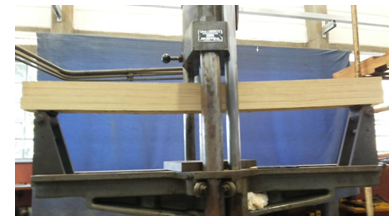 | Figure 1. Three point static bending test |
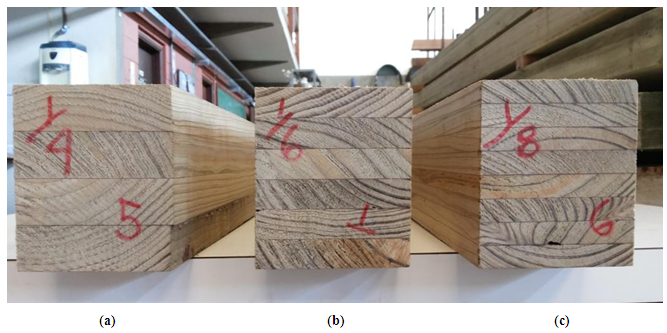 | Figure 2. Experimental conditions to Pinus oocarpa glulam beams - 4 lamellae (a), 6 lamellae (b) and 8 lamellae (c) |
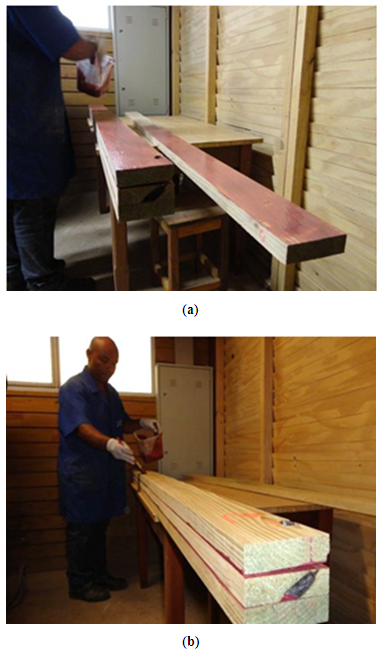 | Figure 3. Gluing CCA treated glulam beams |
 | Figure 4. CCA treated Pinus oocarpa glulam beams |
3. Results and Discussion
- Table 1 shows mean
 , variation coefficients (Cv) and minors (Min) and higher (Max) values of modulus of elasticity (MOE) and modulus of rupture (MOR) on static bending as well as Glulam beams apparent density values.
, variation coefficients (Cv) and minors (Min) and higher (Max) values of modulus of elasticity (MOE) and modulus of rupture (MOR) on static bending as well as Glulam beams apparent density values.
|
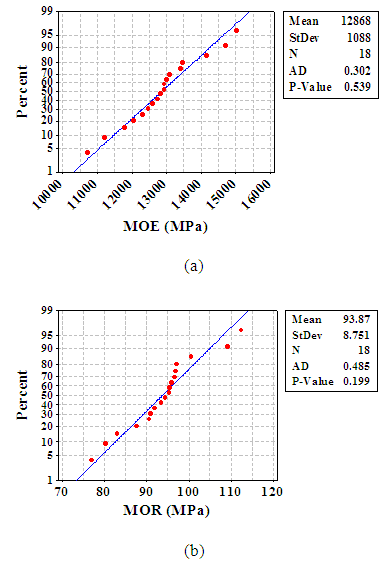 | Figure 5. Normality tests: MOE (a) and MOR (b) |
 | Figure 6. Variance homogeneity test: MOE (a) and MOR (b) |
|
|
 | (1) |
 | (2) |
 | Figure 7. Adjustments by linear regression models: MOE (a) and MOR (b) |
4. Conclusions
- Results obtained in this study can led to conclude that variation of lamellae thickness (12,5mm, 16,70mm, 25mm) or glue lines number (3, 5, 7) did not influence significantly on strength and stiffness in bending, conducting to equivalent results.Thus, searching of economy associated with Glulam beams manufacturing, the best configuration investigated consists in using 25mm thickness lamellae, thereby decreasing adhesive amount, which provides:- reduction of costs involved in gluing;- handling and processing a smaller number of lamellae for final product manufacture;- reduction in the assembly time of beams by the industry.The visual classification of pieces enabled producing Glulam beams free from defects, which resulted in small variability found for values of mechanical and physical properties investigated, wherein the largest value of variation coefficient did not exceed 12%.Visual and mechanical classification in lamellae and tests on Glulam elements in structural size are highly recommended, because volume factor is important in using glulam.From estimation of mechanical properties as a function of apparent density, only to modulus of elasticity was found meaningful model. However, even though significant linear model to estimate MOE, the determination coefficient adjusted was less than 50%, evidencing that density did not led as good estimate in determining strength and stiffness values.
 Abstract
Abstract Reference
Reference Full-Text PDF
Full-Text PDF Full-text HTML
Full-text HTML